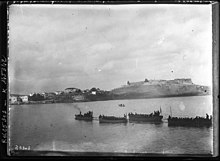Battle of Lesbos (1912)
| Battle of Lesbos | |||||||
|---|---|---|---|---|---|---|---|
| Part of the First Balkan War | |||||||
 Greek troops land at Mytilene, 21 November 1912 | |||||||
| |||||||
| Belligerents | |||||||
|
|
| ||||||
| Commanders and leaders | |||||||
|
|
| ||||||
| Strength | |||||||
| 3,175 | 3,600 | ||||||
| Casualties and losses | |||||||
| 9 killed, 81 wounded | Ottoman garrison captured | ||||||
The Battle of Lesbos took place from 21 November – 21 December 1912 during the
Background
The island of
With the outbreak of the
As a result, the Greeks delayed moving against Chios and Lesbos until operations were concluded on the main front in
Fight for Lesbos

The landing force arrived at Mytilene on 07:00 on 21 November [O.S. 8 November] 1912, and Kountouriotis issued an ultimatum to the local Ottoman commander, requesting his surrender. After negotiations, the Ottoman garrison was given time to evacuate the city, which was promptly occupied by the Greek forces.[10] After this was accomplished, Kountouriotis with the main part of the fleet left the island, leaving behind only the cruiser squadron and two destroyers.[12] Prior to his departure, Kountouriotis formed a militia composed of local Greeks and appointed K. Melas as its commander.[8] At the same time, the Ottoman troops, some 1,500–2,000 men, withdrew to a camp at Filia, some 50 kilometres (31 mi) northwest of Mytilene. The camp, erected during the recent Italo-Turkish War, was well supplied with provisions and munitions.[10]
During the course of the Battle of Lesbos, the Ottomans perpetrated a series of massacres against the local Greek Christian population. The most notable being the massacre of the Christians in
After the reinforcements arrived on 14 December [O.S. 1 December], Syrmakezis had some 3,175 men and eight field guns at his disposal (although some 300 naval infantry served in police duties in the rear).[9] This force was divided in two columns, a southern one at the village of Lambou Myloi and a northern one at Thermi. The two columns began their gradual advance towards the Ottoman camp at Filia on 16 December [O.S. 3 December]. By the night of the next day, they had reached the villages of Dafia and Agia Paraskevi respectively. As Syrmakezis wanted both columns to hit Filia simultaneously, he ordered the northern column halt for a day, while the advance of the southern column continued the next day, only to be stopped by strong Ottoman resistance near the Leimonas Monastery.[9] The southern column still faced stiff resistance and made slow progress on 19 December [O.S. 6 December], but the northern column enjoyed rapid success, reaching the outskirts of Filia by nightfall.[9]
On the next morning, both columns were ordered to launch their attack on Filia, but almost as soon as the Greek advance began, an Ottoman envoy appeared requesting an armistice for negotiations. This was granted, but when the Ottoman commander, Major Abdul Ghani, appeared at 11:00, he claimed that he had not requested negotiations and that he had no proposals to make. Dismissing this as a ploy to gain time, the Greek commander ordered the resumption of the offensive at 14:00. At 22:00, however, the same Ottoman envoy appeared, carrying a letter of surrender signed by the officers of the Ottoman garrison.[9] Syrmakezis ordered an immediate cessation of hostilities, and the instrument of surrender of the Ottoman garrison was signed at 08:00 on the next day.[16]
The capture of Lesbos cost the Greeks nine killed and 81 wounded in action.[17]
Aftermath
The fate of the Aegean islands captured by Greece during the First Balkan War was the subject of prolonged diplomatic negotiations, as the Ottomans initially refused to cede them. Finally, in the
The cession of Lesbos and the other islands to Greece was not finalized until the 1923 Treaty of Lausanne.[21]
References
- ^ a b Soucek 1991, p. 1036.
- ^ a b Soucek 1991, pp. 1036–1037.
- ^ Kiel 2005, pp. 12–13.
- ^ Kiel 2005, p. 13.
- ^ Επίτομη Ιστορία, pp. 119–120.
- ^ a b Erickson 2003, p. 157.
- ^ Erickson 2003, pp. 157–158.
- ^ a b Kargakos 2012, p. 194.
- ^ a b c d e Επίτομη Ιστορία, p. 123.
- ^ a b c d Επίτομη Ιστορία, p. 121.
- ^ Kargakos 2012, p. 193.
- ^ Επίτομη Ιστορία, pp. 121–122.
- ^ Kargakos 2012, pp. 194–195.
- ^ Επίτομη Ιστορία, p. 122.
- ^ Επίτομη Ιστορία, pp. 122–123.
- ^ Επίτομη Ιστορία, pp. 123–124.
- ^ Επίτομη Ιστορία, p. 125.
- ^ Hall 2000, pp. 71, 101–102.
- ^ Gianoulopoulos 1999, pp. 120–123.
- ^ Gianoulopoulos 1999, p. 123.
- ^ Gianoulopoulos 1999, pp. 143–144.
Sources
- Erickson, Edward J. (2003). Defeat in Detail: The Ottoman Army in the Balkans, 1912–1913. Westport, CT: Greenwood. ISBN 0-275-97888-5.
- Gianoulopoulos, Giannis (1999). "Εξωτερική πολιτική" [Foreign policy]. Ιστορία της Ελλάδας του 20ού αιώνα, Τόμος Α′: Οι Απαρχές 1900-1922 [History of Greece in the 20th Century, Volume I: Beginnings 1900–1922]. Vol. 2. Athens: Vivliorama. pp. 107–147. ISBN 960-8087-02-3.
- Hall, Richard C. (2000). The Balkan Wars, 1912–1913: Prelude to the First World War. London: Routledge. ISBN 0-415-22946-4.
- Kargakos, Sarandos (2012). Η Ελλάς κατά τους Βαλκανικούς Πολέμους (1912-1913) [Greece in the Balkan Wars (1912–1913)] (in Greek). Athens: Peritechnon. ISBN 978-960-8411-26-5.
- Kiel, Machiel (2005). "Midilli". TDV Encyclopedia of Islam, Vol. 30 (Misra – Muhammedi̇yye) (in Turkish). Istanbul: ISBN 978-975-389-402-9.
- Soucek, S. (1991). "Midilli". In ISBN 978-90-04-08112-3.
- Επίτομη Ιστορία των Βαλκανικών Πολέμων 1912-1913 [Concise History of the Balkan Wars 1912–1913]. Athens: Hellenic Army General Staff, Army History Directorate. 1987. OCLC 51846788.
